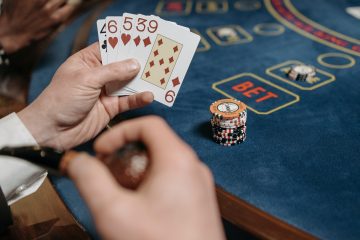Introduction
Baccarat has many distinct variations because it is played in many different nations worldwide. The game of baccarat, known as “Punto Banco,” is popular in Macau, the United Kingdom, Australia, Canada, and the United States. Both “Punto” and “Banco” refer to players or bankers.
Mini-baccarat, midi-baccarat, and grand baccarat are the three variations of the game. Every casino table game has a built-in advantage that generates revenue for the establishment. Typically, the casino edge is expressed as a percentage.
Baccarat has a house advantage of:
1.17% for banker
Person – 1.36%
14.12% tied with an 8:1 payout.
The layout of a Baccarat Table
The stack of checks in front of the dealer is the bank.
The commission box is the lengthy rectangle next to the bank. Numerous boxes with numbers will be seen. The location of each number corresponds to the player’s seat. The dealer will mark this box each time the player owes a commission until the player pays it.
On the left side of the table, there is a shoe. The shoe will often be 8 decks or higher.
The user will have three options for where to stake their money when they place a wager. Player, Banker, or Tie.
The commission and tie boxes are marked in the betting circles on most baccarat tables. You’ll see that several alterations to the layout have been inspired by Chinese culture because this game is quite well-liked in that country. Since 4 is said to be unlucky in China because it sounds similar to the word “death,” many baccarat layouts exclude the fourth position. As a result, the number of betting places will increase to 8. Additionally, because 8 sounds close to “prosper” and “wealth,” it is considered an auspicious number in Chinese culture.
What Is Basic
The game’s goal is to place a wager on the hand you believe will have the highest overall worth.
The dealer will deal with two sets of two cards. The Player will receive one set, and the Banker will receive the other. After adding up each set of cards, the side with the highest total wins the hand.
The final result of summing the cards must always be a single digit. For instance, the result would be 15 if your two cards were an 8 and a 7. However, as only single-digit totals are acceptable, it is common to omit the “tens” place value. Remove the one, and the actual capacity is now 5. Due to this law, all cards with a 10 value equal zero, and all aces equal one. All place values must follow this criterion. Drop the place value of the tens so that your good total is now five. For instance, if you draw two 10s and a 5, the capacity is 25.
Making content requires significant time, money, and effort, especially if you want to do it well. And because I believe in the principle of “Free Information,” crowdsourcing is the only way I can generate enough revenue to support this website. This implies that YOU are responsible for the fact that this knowledge is still freely accessible to everyone online. Therefore, please keep the website by becoming a Patreon Patron right now.
3rd Card Rule
How do you determine whether it’s OK to draw the third card? The casino will provide dealers with a chart that they must memorize. Most casinos adhere to the same fundamental principles.
The player must draw a third card if the sum of their first two cards is between 0 and 5.
The player must stand if the sum of their first two cards is between 6 and 7.
The player has a “Natural” hand, and no additional cards are drawn if their first two cards total between 8 and 9. There can only be two cards in a “Natural” hand.
The banker must draw a third card if the sum of their first two cards is between 0 and 2.
The Banker will always draw a card if his first two cards total a 3, except when the Player’s third card is an 8.
The Banker will only draw a third card if the Player’s third card is a 2–7 if the Banker’s first two cards total a 4.
If the Player’s third card is a 4 – 7, the Banker will draw a third card if the Banker’s first two cards total a 5.
The Banker will only draw a third card if the Player’s third card is a 6 or 7 if the Banker’s first two cards total a 6.
The banker must stand if the sum of their first two cards is a 7.
The Banker has a “Natural” hand, and no additional cards are drawn if the first two cards add up to 8 or 9. There can only be two cards in a “Natural” hand.
The Banker will always draw a third card if their first two cards equal a 0 to 5, and the Banker will always stand on a 6 to 9 when the Player stands on 6 to 7.
The Banker will always stand on a 6 if the Player doesn’t draw a third card.
Tie
The third wager, known as the Tie, only pays off if the final totals of the Player and the Banker are equal. The tie bet fails if the Player and Banker are not the same. The player can place a single wager on the tie or a chance together with a Player/Banker wager. The Banker and Player bets are not forfeited in a draw. These wagers win.
In the event of a tie, the payout is typical “8 to 1” or “9 for 1.” it is just the same. If a wager returns 8 to 1, it indicates you will get back 8 times what you bet. The casino will offer you 9 units in exchange for your one team if the bet pays 9 for 1.
Commission
I frequently hear newcomers ask, “Wait! Why did my dealer deduct cash from my winnings? They’re not attempting to steal from you; this is a commission, after all. If the player prevails, they are paid 1 to
If the Banker prevails, the wager is settled at 1 to 1 minus a 5% commission.
Why levy a 5% commission on the casino? Both the Player and the Banker receive a payout of 1:1, but it has been determined that throughout an 8-deck run, the Banker will prevail in three to four more hands than the Player. The casinos have decided to impose a 5% commission on bankers to address this.
How would you calculate the 5% commission? Which method would you use? Do not panic; it is more straightforward than it appears.
You can use two approaches; the first is a straightforward calculation you can perform mentally. 10% of the wager should be divided by two.
Or you may learn the fundamental chart by heart.
You can play even the most basic baccarat games if you keep in mind that every $5 wager requires a $0.25 commission, every $25 bet requires a $1.25 charge, and every $100 bet requires a $5 commission.
$0.25 Commission on a $1 – $5 Bet
$0.50 Commission on a $6 to $10 bet
$11 minus $15 bet equals $0.75 commission.
$1 Commission = $1 – $20 Bet
$1.25 Commission = $21 – $25 Bet
$2.50 Commission for a $50 wager
$5 Commission for a $100 wager.
$25 commission on a bet of $500.
$1,000 paid equals $50 in commission.
Did you notice that the same $0.25 commission applies to bets of $1 and $5? Because commissions are paid to the nearest quarter, this is the explanation. “Breakage” is another phrase for this, which refers to when the amount is rounded up or down to the casino’s advantage.
When breakage is in effect, you can’t ask the player who placed a $12 wager for a $0.10 fee on the additional $2. The dealer will round up the player’s bet to the nearest $5 and add a $0.25 commission if it is between $1 and $4.
You must pay a commission on your winning Banker bet, but the dealer will still pay you “color-for-color” is correct. For this reason, in front of the dealer’s position, casinos have a long rectangle with numerous boxes that contain numbers. After paying the successful Banker bet, the dealer places the appropriate commission amount in the box. The commission will accumulate until you pay it before leaving the table, at the end of each shoe, or whenever you feel like it.
Darby Bet
You can also encounter a wager known as the Dragon Bet. The participants can place this additional wager at any moment. Whether the player is betting on that hand or not, the player may wager on either the Banker’s or the Player’s hand.

